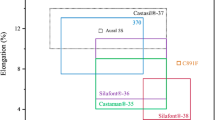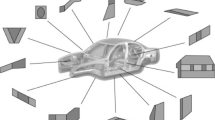Abstract
The effect of the strength ratio extracted from an Archard model for wear is used to describe the wear rates expected in hot forging dies. In the current study, the strength ratio is the strength of the hot forging die to the strength of the work piece. Three hot forging die steels are evaluated. The three die steels are FX, 2714, and WF. To determine the strength of the forging die, a continuous function has been developed that describes the yield strength of three die steels for temperatures from 600 to 700 °C and for times up to 20 h (i.e., tempering times of up to 20 h). The work piece material is assumed to be AISI 1045. Based on the analysis, the wear resistance of WF should be superior and FX should be slightly better than 2714. Decreasing the forging temperature increases the strength ratio, because the strength of the die surface increases faster than the flow strength of AISI 1045. The increase in the strength ratio indicates a decrease in the expected wear rate.







Similar content being viewed by others
References
M. Bayramoglu, H. Polat, and N. Green, Coast and Performance Evaluation of Different Surface Treated Dies for Hot Forging Process, J. Mater. Process. Technol., 2008, 205, p 394–403
R. Shivpuri and S. Babu, Die Wear, Metalworking: Bulk Forming, Vol. 14A, ASM Handbook, ASM International, 2005, p 62–83
C. Dahl, V. H. Vazquez, and T. Altan, Estimation of Die Wear in Hot Forging, Nov 4-5, 1999, (Porto Alegre, Brazil), III Conferecia International de Forjamento [XX Senafor]
J. Zhao, J. Yi, and S. Luo, Study on the Rules and Effect of Wear on Die Service Life in Steel Synchronizer Gear Ring Forging Process, Adv. Mater. Res., 2011, 291-294, p 668–671
B.A. Behrens, Finite Element Analysis of Die Wear in Hot Forging Process, CIRP Ann. Manuf. Technol., 2008, 57, p 305–308
C. Choi, A. Groseclose, and T. Altan, Estimation of Plastic Deformation and Abrasive Wear in Warm Forging Dies, J. Mater. Process. Technol., 2012, 212, p 1742–1752
J.H. Kang, L.W. Park, J.S. Jae, and S.S. Kang, A Study on a Die Wear Model Considering Thermal Softening: 1) Construction of the Wear Model, J. Mater. Process. Technol., 1999, 96, p 53–58
J.H. Kang, L.W. Park, J.S. Jae, and S.S. Kang, A Study on a Die Wear Model Considering Thermal Softening: 2) Application of the Suggested Wear Model, J. Mater. Process. Technol., 1999, 94, p 183–188
J.F. Archard, Contact and Rubbing of Flat Surfaces, J. Appl. Phys., 1953, 24, p 981–988
J.H. Hollomon and D.L. Jaffe, Time Temperature Relations in Tempering Steel, Trans. Metall. Soc. AIME, 1945, 16, p 223–249
F.R. Larson and J. Miller, A Time-Temperature Relationship for Rupture and Creep Stresses, Trans. ASME, 1952, 74, p 765–775
D. Kim, H.C. Lee, B.M. Kim, and K.H. Kim, Estimation of Die Service Life Against Plastic Deformation and Wear During Hot Forging Process, J. Mater. Process. Technol., 2005, 166, p 372–380
E. Virtanen, C.J. Van Tyne, B.S. Levy, and G. Brada, The Tempering Parameter for Evaluating Softening of Forging Die Steels, J. Mater. Process. Technol., 2013, 213, p 1364–1369
U. Stahlberg and J. Hallstrom, A Comparison Between Two Wear Models, J. Mater. Process. Technol., 1999, 87, p 223–229
T. Wanheim, N. Bay, and A.S. Peterson, A Theoretically Determined Model for Friction in Metalworking Processes, Wear, 1974, 28, p 251–258
P.R. Burte, Y.T. Im, T. Altan, and S.L. Semiatin, Measurement and Analysis of Heat Transfer and Friction During Hot Forging, J. Eng. Ind., 1990, 112, p 332–339
E. Summerville, K. Venkatesan, and C. Subramanian, Wear Processes in Hot Forging Press Tools, Mater. Des., 1995, 16, p 289–294
T. Heidenblut, K.K. Mohwald, T.A. deiBer, M. Bistron, B.A. Behrans, and F.W. Bach, Wear Characterization of Forging Dies Using a Large Chamber Scanning Electron Microscope, Microsc. Microanal., 2007, 13(S02), p 104–105
T.G. Byrer, Forging Handbook, S.L. Semiatin, and D.G. Vollmer, Eds., Forging Industry Association, 1985, p 88–91
T. Altan, F. Boulger, J. R. Becker, N. Akgerman, and H.J. Henning, Forging Equipment, Materials, and Processing. Battelle Columbus Labs, 1973, p 166
P. Mencin, C.J. Van Tyne, and B.S. Levy, A Method for Measuring the Hardness of the Surface Layers of Hot Forging Dies Using a Nano Indenter, J. Mater. Eng. Perform., 2009, 18, p 1067–1072
S. Giskaas, P. Wolfram, K.O. Findley, B.S. Levy, and C.J. Van Tyne, Yield Strength of Hot Forging Dies at Working Temperatures, CD Proceedings AMPT, 2012, Paper No. 12019
N. Wan, W. Xiong, and J. Suo, Mathematical Model for Tempering Time Effect on Quenched Steel Based on Hollomon Parameter, Am. J. Mater. Sci. Technol., 2005, 21, p 803–806
Acknowledgments
A. Finkl & Sons are thanked for supplying the experimental steels. G. Brada of Finkl is appreciated for a number of helpful discussions.
Author information
Authors and Affiliations
Corresponding author
Rights and permissions
About this article
Cite this article
Levy, B.S., Van Tyne, C.J. Effect of Die Strength and Work Piece Strength on the Wear of Hot Forging Dies. J. of Materi Eng and Perform 24, 416–425 (2015). https://doi.org/10.1007/s11665-014-1292-1
Received:
Revised:
Published:
Issue Date:
DOI: https://doi.org/10.1007/s11665-014-1292-1




